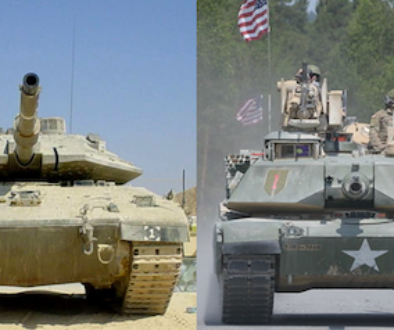The PT-76 Was the Little Soviet Amphibious TankThat Could!
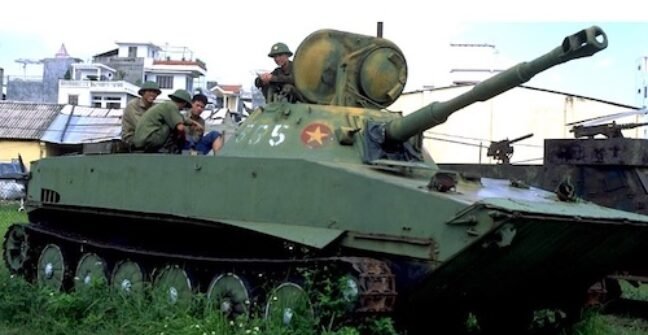
Vietnamese PT76 – Soldiers relaxing on tank in Hanoi. Date August 1998
Source Own work Author Bob Tubbs
A lightly armored Cold War tank gave U.S. Special Forces a nasty shock in the Vietnam War

by Sébastien Roblin
journalist on International Affairs, Security and Military History
The PT-76 seems like a minor oddity of the Cold War — a Soviet amphibious light tank with thin armor and an unimpressive gun. Certainly it seemed bound for rough treatment on modern battlefields full of heavy weapons and heavier tanks. But the floating PT-76 chalked up a remarkable record, carrying knife-wielding Himalayan soldiers into battle, sinking gunboats on
the Ganges Delta, duelling powerful U.S. Patton tanks in Vietnam, and launching amphibious surprise attacks on both sides of the same Middle Eastern war. The first article in this two-part series will look at the origin and characteristics of the PT-76, the nasty shock it gave U.S.forces in Vietnam, and the historic countermeasure used against it.
Just prior to World War II, the Soviet Union developed a series of amphibious light tanks, the T-37, T-38 and T-40. However, these lightly armored two-man vehicles, which were all armed with a single machine gun, were poorly matched against German Panzers that invaded in 1941. Within the first six months of the invasion, most were lost and replaced by heavier vehicles. However, the Soviet military returned to the concept after World War II, and in 1949, approved for production the Object 740 prototype designed by Nikolay Sashmurin at the Kirov factory in Leningrad.
Shashmurin’s vehicle employed two innovative side-mounted hydro jets for propulsion in water. A crew of three needed only to lower a trim vane over the hull and turn on the bilge pumps, and the tank could swim at six miles per hour on river or seawater, using panels to block the hydrojets on one side or the other for steering. It could swim for hours if necessary and even fire its main gun while afloat.
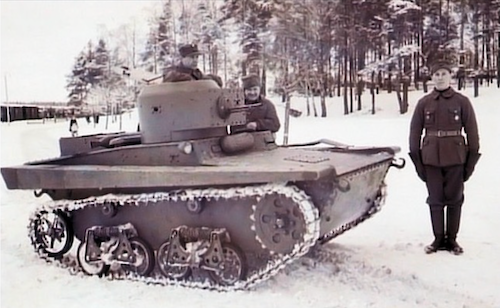

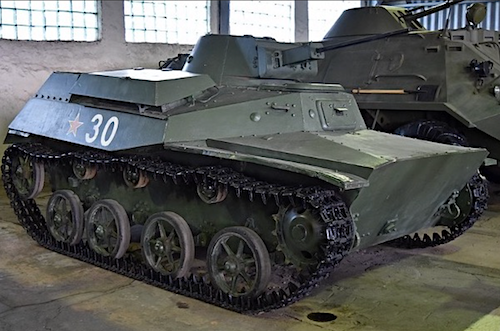
The 14.6 ton vehicles also had good all-terrain mobility on land due to the Christie suspension and hydraulic shock absorbers, though the PT-76 was hardly nimble, with a maximum speed of 27 miles per hour.
The tank’s rolled steel hull was unusually large and thinly armored to enable flotation. It did not exceed 25 millimeters of armor on the turret, and half or less than that on the sloped hull. This was adequate to protect against rifle bullets — but not .50-caliber machine gun rounds or shrapnel from heavy artillery.
The vehicle entered production in 1951 as the PT-76, named after the rifled 76-millimeter D-56 gun in the turret, which had the same caliber and barrel length as the F34 gun on World War II T-34 tanks. However, the D-56 could use more powerful ammunition.
While most of the 40 onboard shells were high explosives or armor piercing shells that could penetrate 100 to 127 millimeters of armor, later PT-76s received special low-velocity BK-350M shaped-charge HEAT rounds that could penetrate 200 to 280 millimeters. These could threaten the heavier tanks of the era, though only at short range.
A coaxial 7.62 millimeter machine gun in the turret served as a secondary weapon, though some PT-76s also mounted a heavy DsHK 12.7-millimeter machine gun atop the turret. An armored personnel carrier derivative called the BTR-50 was also widely produced.
Sources variously claim the Soviet Union built between 4,000 and 12,000 PT-76s through 1968. Its chassis would serve in many other armored fighting vehicles, including ASU-85 airborne assault gun, the ZSU-23–4 self-propelled anti-aircraft system, and the SA-6 SAM system.
However, the original PT-76 had a number of flaws. The un-stabilized main gun was highly inaccurate on the move, the crew had no protection from nuclear, biological or chemical weapons, and only the driver had any night vision equipment. A PT-76B variant introduced in 1959 addressed all but the last issue. It featured a stabilized D-56TM gun, a redesigned hull, new auxiliary fuel tanks and an uprated V-6M engine.
The Soviet PT-76s served in naval infantry units and regimental and divisional reconnaissance units. Between one and two thousand were also exported to more than 25 countries. China even produced 1,500 of its own version, the Type 63 tank. This was not an exact clone, however, as it used a locally developed propulsion system and a larger 85 millimeter gun.
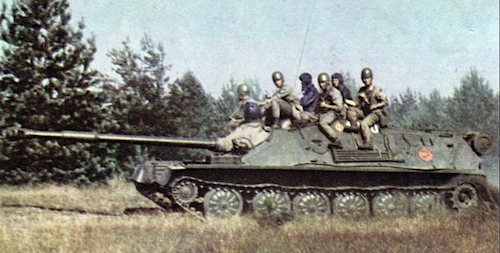
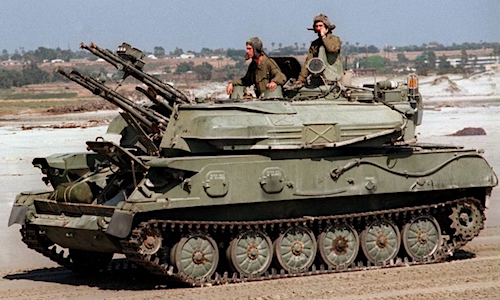

Ghost tanks of Vietnam

For the first half of the Vietnam War, North Vietnam built up its modest tank fleet without committing it to battle. However, it finally committed its “ironclad vehicles” to the fight during the 1968 Tet Offensive, when North Vietnamese Army troops supported Viet Cong guerrillas in an all-out assault on the major cities and military bases throughout South Vietnam.
Hanoi supplied the Viet Cong via the Ho Chi Minh trail, which passed through Laotian territory. To monitor activity on the trail, the Laotian government dispatched the 700 men of the BV-33 Elephant Battalion to maintain an outpost in the town of Ban Houei Sane. The outpost also protected more than 2,000 refugees.
On Jan. 23, 1968, a week before the Tet Offensive began, the NVA’s 24th Regiment assaulted the camp at night, supported by a company of PT-76s from the 198th Armored Battalion. These had made the 800 mile journey down the Ho Chi Minh trail to join the battle. It would be the NVA’s first tank action.
It didn’t go entirely smoothly. The PT-76s bogged down several times while crossing swamps, causing the infantry — who were not used to fighting alongside friendly tanks — to engage the Elephant Battalion first. But once the PT-76s entered the fray the Laotian troops fell back in disorder.
[perfectpullquote align=”right” bordertop=”false” cite=”” link=”” color=”#5a5a5c” class=”” size=”50″]One team reportedly hit the same tank with nine rockets to no result.[/perfectpullquote]
North Vietnamese troops overran the camp in three hours before Laotian reinforcements could arrive, and the surviving soldiers and refugees fled eastward, eventually finding shelter at the Lang Vei Special Forces camp in South Vietnam.
However, the survivors’ misfortunes had only begun. Two weeks later, approaching midnight on Feb. 7, a battalion of NVA troops spearheaded by 11 to 13 PT-76s of the 198th assaulted Lang Vei. Five hundred civilian militia and Montagnard fighters defended the camp’s lengthy perimeter, backed up by 350 surviving troops of the Elephant Battalion and 24 U.S. Army Green Berets led by Capt. Frank Willoughby.
Despite intelligence reports warning of the presence of NVA tanks in the area, U.S. troops were shocked by the attack. Nonetheless, One of the camp’s two M40 106-millimeter recoilless rifles managed to knock out three of the thin-skinned vehicles, one of which was abandoned by a female crew. However, this did not deter the remaining North Vietnamese tankers as they crushed the fences, anti-personnel mines and barbed wire ringing the camp, clearing a path for infantry to follow.
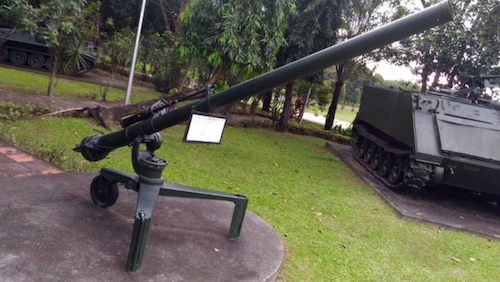
M40 106-millimeter recoilless rifle
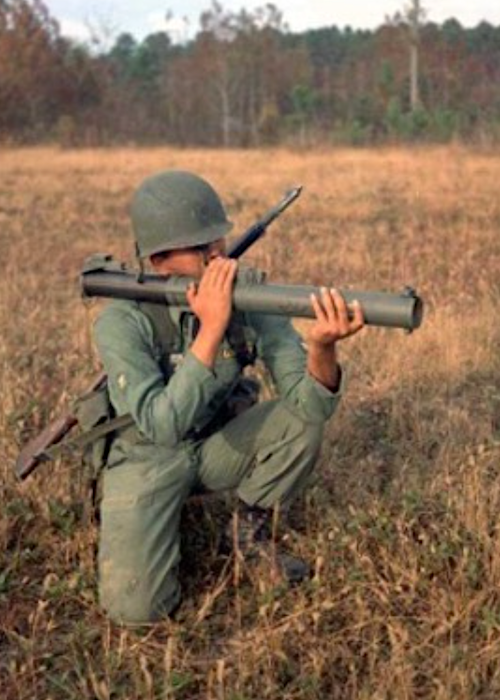
M72 66-millimeter anti-tank rockets
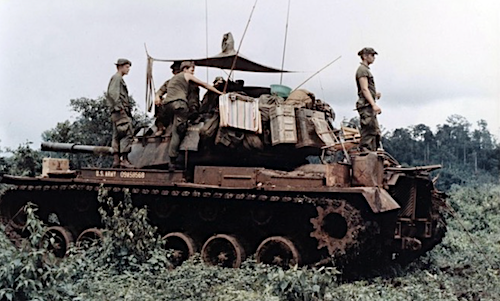
M48-of-B-Troop-1st-Squadron-10th-Cavalry-4th-Infantry-Division-in-the-Central-Highlands-June-1969.
The tanks’ 76-millimeter guns took out the recoilless rifle, and began blasting apart one fortified bunker after another.
The U.S. commandos began firing off their disposable M72 66-millimeter anti-tank rockets at short range. The weapons should have easily penetrated the light tanks, but instead repeatedly misfired, missed or failed to have any effect when they did hit. One team reportedly hit the same tank with nine rockets to no result.
Another tank hunting group finally managed to set a PT-76 on fire with a hit to the rear armor — the fourth and last one destroyed in the battle.
By 2:30 in the morning, the light tanks were roaming about the center of the camp, blasting away with their cannons and machine guns and besieging the American officers trapped in the command bunker.
Neither artillery and air strikes, nor a counterattack by Laotian troops led by two American Special Forces officers, could succeed in driving away the attackers. The nearby Marine base at Khe Sanh was supposed to support the camp in an emergency, but refused to dispatch reinforcements due to its own ongoing siege.
The surviving South Vietnamese, American and Laotian troops made their escape the following afternoon after the rest of the camp had fallen, leaving behind more than 300 dead.
The NVA had effectively used its PT-76s to overwhelm targets that lacked adequate anti-tank weapons. However, its tankers eventually encountered a intimidating opposition in the form of American M48 Patton tanks which weighed three times as much and boasted 90-millimeter guns and 175 millimeters of turret armor.
The first clash between the two vehicles was decidedly unconventional. Three months after the fall of Lang Vei, an observation plane spotted a PT-76 crew washing their vehicle in the Ben Hai River. The plane radioed the tank’s coordinates to an M48 of the U.S. Marine 3rd Armored Battalion at Con Thien, which raised its gun barrel high up into the air to attack with indirect fire.
Patton tanks frequently served as ad-hoc artillery in Vietnam, but it was rare in any conflict for a tank to target another in this manner. The third high explosive shell landed squarely on the tank, causing the crew to abandon the vehicle, which was later hit by an F-4 Phantom air strike.
Two U.S. Air Force McDonnell F-4D-30-MC Phantom II fighters (s/n 66-7576, 66-7628) from the 435th Tactical Fighter Squadron, 8th Tactical Fighter Wing, over Vietnam, off the wing of a Boeing KC-135A Stratotanker. Both Phantoms are armed with three SUU-30/B cluster bombs (right wing), three LAU-3 rocket launchers (left wing) and six Mk 82 227 kg bombs (centerline). F-4D 66-7576 was written off in Vietnam on 30 July 1972.
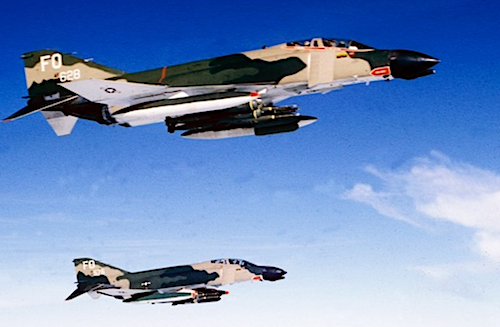
F-4Ds-435th-TFS-over-Vietnam – circa 1967-1972
Source National Museum of the U.S. Air Force photo 110224-F-XN622-006
Author USAF

A KC-135A refueling a B-52D during the Cold War.
Both aircraft types were operated by the Strategic Air Command.

SUU-30-B-cluster-bomb
The following year on March 3, 1969, NVA PT-76s spearheaded a night attack by the 66th Regiment on the American Special Forces camp at Ben Het, which hosted a battery of enormous M107 175-millimeter self-propelled guns.
A platoon of three Pattons from B Company of the 1st Battalion, 69th Armored Regiment guarded the camp, entrenched in sandbag positions on the perimeter along with two M42 Duster anti-aircraft vehicles. Hearing tanks approaching late at night, the lead M48 turned on its one-million-candlepower searchlight.
Abruptly, one of four approaching PT-76 detonated an anti-personnel mine, revealing the silhouetted tanks in the explosion’s afterglow. The night erupted as the American and Vietnamese tanks exchanged armor-piercing shells. One Patton destroyed a PT-76 on its second shot.
…. but this time the American forces exacted a revenge both deadly and historic.
Meanwhile, company commander Capt. John Stovall was perched on the turret of the command tank, illuminated by its Xenon spotlight, when a 76-millimeter round struck the vehicle, blasting Stovall and the tank commander off the turret and killing two of the crew. Relief tank crews quickly took their place and brought the Patton back into action.
The American firebase called in 81-millimeter mortar strikes and AC-47 gunships, while the M48 expended all of their anti-tank shells and switched to high explosives. Finally, a second platoon of Pattons relieved the base, causing the NVA to withdraw. The following morning, U.S. troops found two destroyed PT-76s and a BTR-50PK on the perimeter of the camp. This marked the only engagement between U.S. and North Vietnamese tanks during the Vietnam War.
A U.S. Air Force Douglas AC-47D (S/N 45-0927) in September 1968 after the 4th Air Commando Squadron became the 4th Special Operations Squadron of the 14th Special Operations Wing, probably at Nha Trang, South Vietnam.
Ben Het would be revisited by the North Vietnamese amphibious tanks three years later in June 1972 — but this time the American forces exacted a revenge both deadly and historic.
Just a month before, an operational testing unit of UH-1B helicopters equipped with new BGM-71 TOW anti-tank missiles had arrived in Vietnam. These swooped to the aid of the camp, where they fired off their wire-guided missiles from their three-tube XM26 launchers, destroying three PT-76s and driving the rest away.
2 May 72 The TOW missile system in its airborne configuration (XM26 armament subsystem) became the first American-made guided missile to be fired by U.S. soldiers in combat. The first airborne TOWs had arrived in Vietnam on 24 April 72, six days after MICOM had received the initial deployment order. This was a notable achievement considering that the system was still in the experimental stage and there were only a limited number of complete subsystems available. The airborne TOW served in Vietnam until 1973. 1972
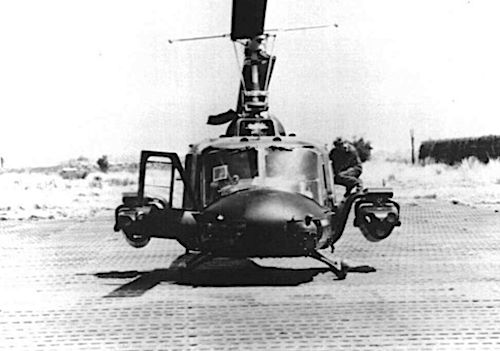
Huey-armed-with-TOW-missiles-in-Vietnam – Source The United States Army Aviation and Missile Life Cycle Management Command Official Web-SiteAuthor U.S. Army Missile Command (MICOM)

US-Marines-riding-atop-an-M48-in-Vietnam-in-April-1968

A-U.S.-Air-Force-Douglas-AC-47D-guun-ship
The tank hunting Hueys destroyed five more PT-76s around Kontum the following week. The early TOW missiles could penetrate 430 millimeters of armor, so the 25 millimeters of steel on a PT-76’s turret front did not offer much protection.
Thus, the PT-76 won the dubious distinction of being one of the first tanks destroyed by helicopter-fired anti-tank missiles — though, ironically, much lighter armament would likely have sufficed to knock one out.
As the U.S. withdrew from Vietnam, the North Vietnamese tankers made greater use of heavier T-54s, Type 59 and captured M41 Bulldog tanks alongside the PT-76 in pitched battles such as Loc Ninh and An Loc in 1972. These armored units spearheaded the offensive that led to the fall of Saigon in 1975.
Type 59 tank in Royal Australian Armoured Corps Tank Museum, Puckapunyal, Australia. This tank was captured by ARVN troops in South Vietnam (Hai Lang, Quang Tri Province) on 4 July 1972.
Still today, the Vietnamese military maintains hundreds of upgraded PT-76s in its inventory, as well as Chinese-made Type 63s.
A Chinese Type 63 light tank seen from above at the Beijing Military Museum.
The tank hunting Hueys destroyed five more PT-76s around Kontum the following week. The early TOW missiles could penetrate 430 millimeters of armor, so the 25 millimeters of steel on a PT-76’s turret front did not offer much protection.
Thus, the PT-76 won the dubious distinction of being one of the first tanks destroyed by helicopter-fired anti-tank missiles — though, ironically, much lighter armament would likely have sufficed to knock one out.
As the U.S. withdrew from Vietnam, the North Vietnamese tankers made greater use of heavier T-54s, Type 59 and captured M41 Bulldog tanks alongside the PT-76 in pitched battles such as Loc Ninh and An Loc in 1972. These armored units spearheaded the offensive that led to the fall of Saigon in 1975.
Type 59 tank in Royal Australian Armoured Corps Tank Museum, Puckapunyal, Australia. This tank was captured by ARVN troops in South Vietnam (Hai Lang, Quang Tri Province) on 4 July 1972.
Still today, the Vietnamese military maintains hundreds of upgraded PT-76s in its inventory, as well as Chinese-made Type 63s.

A Chinese Type 63 light tank


